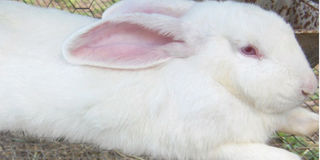Rabbit-rearing: A worthy investment

Rabbits are usually reared for their meat, which is as tasty as chicken meat.
What you need to know:
Rabbits multiply fast and are easy to look after. Though overlooked, rabbit-rearing is potentially lucrative, writes Fred Muzaale
Rabbits are domesticated edible rodents which are reared for meat, fur and wool (clothing). But in Uganda, a few people who rear rabbits largely keep them as pets while others rear them for meat with many not knowing that they can mint a lot of money if they rear them on a commercial scale.
Although taboos influencing the acceptance of consuming rabbit meat don’t appear to be a major concern, one common prejudice is the resemblance or rabbits to rats despite the fact that rabbit meat is as tasty as chicken meat.
Because of this, rabbit farming is uncommon in many households with the national livestock census estimating the number of rabbits in the country at about between Shs500,000 and Shs700,000 only.
Mr Hussein Kigozi, an animal husbandry professional, says rabbit-rearing has the potential to improve the diets and incomes of many households as well as soil fertility.
He adds that even though rabbit meat has a small local market, it is on high demand in local hotels where they constitute one of the main meats served in the Middle East.
“Rabbit meat is highly valued because it is rich in poly unsaturated fatty acids and is categorised as white meat, which is extremely good for health and recommended by medical personnel,” Mr Kigozi says.
He explains that to tap such markets, farmers need to be organised and carry out the venture on a commercial scale because most of the buyers want to deal with farmers who can ensure a stable supply of rabbits in a given quantity and at a specific period.
An employee in Colline Hotel, Mukono, who preferred not to be named, says that rabbit meat is one of the major meats cherished by their customers. The hotel buys rabbits mainly from local farmers in the area at a cost of Shs 15,000 each.
But he adds that rabbits are difficult to get because very few people rear them. “Our demand is 10 rabbits only a week but getting this number is not easy.”
Mr Kigozi observes that rearing rabbits has more advantages than disadvantages.
The first advantage is that rabbits mature quickly and are ready for consumption at only three months of age. This period is far shorter than the period that a local chicken takes to mature (almost one year ).
Another advantage is that rabbits have a short gestation period of only 30 days and a female rabbit (known as a doe) can produce about 8-10 kits per month. This means a doe can, on average, produce about 70 kits a year compared to only one calf a year in cattle.
A rabbit, by nature, can conceive 24 hours after giving birth, which means it can produce kits almost every one-and-half months. Also, rabbit droppings provide high quality manure, which can be used as fertilisers by vegetable farmers.
Mr Kigozi states that rabbits are easy to look after because they feed on almost all fresh leaves and can also be fed on maize bran and kitchen waste.
Another advantage is that rabbits are not susceptible to malnutrition. They manufacture some of the vital body nutrients within their bodies because they are caproghagic, that is, rabbits eat their faeces from which they extract more body nutrients which are manufactured in their large intestines.
In addition, rabbit rearing is not labour-intensive if you compare them to goats or cattle which means a farmer spends less on labour.
Disadvantages of rabbit rearing
The major disadvantage of rabbit rearing is that their meat is not consumed in many communities. This creates a small market for rabbits locally.
Another one is that the monetary value of rabbits cannot be well explained which each person paying a dissimilar price.
Rabbits are also susceptible to predators like dogs when reared free range.
Construction of a hutch
Mr Kigozi says that a hutch (rabbit house) can be constructed from mud and wattle or with bricks and the roof covered by iron sheets or grass. But it should be constructed well above the ground with the floor constructed from welded wire mesh to allow the droppings to fall through which keeps the hutch clean. He also says that the hutch should be well ventilated because rabbits are susceptible to respiratory diseases.
The upper part of wall should be made of nets to allow maximum ventilation while the floor can be covered by dry grass or old clothes which can act as a conformable bedding for rabbits especially when they are about to give birth even though female rabbits also discard some of their hair and use it as beddings for their young ones.
Rabbit diseases
Like poultry, rabbits are also attacked by Coccidiosis. This disease is mostly caused by poor hygiene in the hatch. Symptoms include bloody diarrhoea, dirty hind quarters, rough hair coat and poor growth.
It can be treated by putting amprorium powder in the drinking water or food. Proper hygiene in the hutch should also be maintained.
Another disease is the Ear mange which is caused by a mite which burrows deep into the external ear tissue causing intensive itching, scratching. This subsequently results into sore wounds. This can be treated by applying an acaricide, most preferably Amitraz on the affected areas.
To tap the rabbit market available in local hotels and outside of the country, Mr Kigozi says farmers need to be organised to rear rabbits on a commercial scale.




